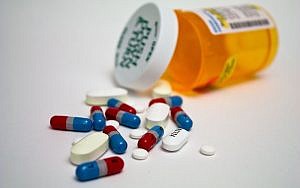Native American communities, hard hit by the opioid crisis, seek innovative solutions
PHOENIX — Native American advocates are seeking more funding and new ways to tackle the opioid crisis in Indian Country as overdose death rates continue to rise.
Native Americans have the second-highest death rate related to opioid use in the nation – a number that’s been on the rise for nearly two decades. In 2017, the rate hit 15.7 deaths per 100,000 people, according to the U.S. Centers for Disease Control and Prevention; only whites are dying at a higher rate — 19.4 per 100,000 people.
The crisis took center stage at a gathering last week of Native American health experts sponsored by the National Indian Health Board.
Stacy Bohlen, CEO of the board, said a number of factors have contributed to the opioid epidemic among Native Americans. One, she said, is a lack of access to basic health care and treatment when someone is suffering.
“People can’t afford to get care but can certainly afford painkillers,” Bohlen said.
According to Bohlen, improving the public health system for American Indians and Alaska Natives would go a long way toward preventing opioid abuse and overdoses.
“For every dollar you spend in prevention, you save $5 in provision of direct medical care,” she said.
Shervin Aazami, a policy analyst at the health board, said the opioid crisis in Indian Country has been overlooked by most Americans.
“This invisibility contributes to the lack of awareness, lack of correct funding, lack of technical assistance and resources directly to the tribes,” Aazami said, adding that such resources would allow tribes to address the problem on their own terms as sovereign nations and in more culturally appropriate ways.
The federal government has distributed grant money to states to address the addiction crisis.
“However, they often neglect to allocate money towards the tribes, leaving the Native people to sit waiting,” Aazami said.
Last year, President Donald Trump signed into law opioid relief legislation that included a specific 5 percent set aside to ensure that some federal funding goes directly to Native organizations battling the problem. Aazami said that’s not nearly enough.
At the tribal health conference last week, Virginia Hedrick, director of policy and planning at the California Consortium for Urban Indian Health, spoke about steps communities can take to address the opioid crisis, including reducing the stigma around addiction itself as well as alternative pain management.
Hedrick’s organization plans to distribute the drug naloxone, medication that rapidly reverses the effects of an opioid overdose, into the hands of as many community members as possible. The group also is training providers at clinics to increase access to medication-assisted opioid treatment, where doctors can prescribe different medications, such as buprenorphine, that can help an individual overcome addiction.
“What I hope to accomplish is really sharing the data on how our program is effective, sharing information on putting naloxone into the hands of more community members, so that we don’t continue to lose more people to overdoses, and to reduce stigma around addiction and to reduce stigma around alternative pain managements,” Hendrick said.
Hedrick said supporting mental health services and alternative pain management systems and making insurance easier to access also could help address the crisis in Indian Country.
“It could be that an individual has suffered trauma throughout their life, and an opioid is a way to address a mental health issue,” she said. “We don’t typically see individuals who are struggling with an addiction that don’t have an underlying issue.”
SUBMIT FEEDBACK
Click Below to:




